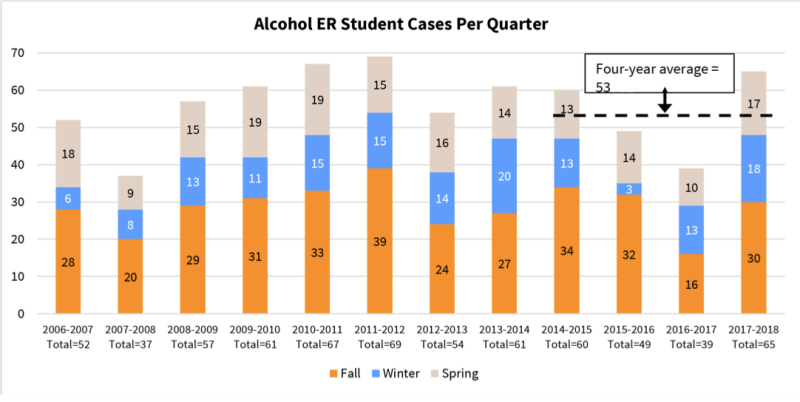Stanford sends at least one student per week to the emergency room due to alcohol consumption, reports on campus alcohol use released by Vice Provost for Student Affairs Susie Brubaker-Cole on Thursday show.
“Today’s report shows that despite numerous efforts to reduce the harmful impact of alcohol in our community, the problem has persisted,” Brubaker-Cole wrote in an email to all students.
The three reports are expected to be the first wave of an annual compilation of data, Brubaker-Cole said. The first displays survey data from AlcoholEdu between 2012 and 2018, the second displays campus-wide alcohol use trends and the third displays additional alcohol-related data, such as use of Stanford’s safe rides program 5-SURE and transport numbers.
At the start of the quarter, Brubaker-Cole announced a number of different alcohol prevention initiatives, including the compilation of these reports and the expansion of 5-SURE and Cardinal Nights, Stanford’s alcohol-free social programming. She also announced the creation of an Alcohol Solutions Group in collaboration with Stanford Law School to develop more healthy approaches to alcohol on campus. The group convened for the first time on Feb. 20.
Alcohol trends
Information on trends in campus-wide alcohol use over the past five years was taken from the Core Alcohol and Drug Survey, which was replaced by the the Office of Alcohol Policy and Education (OAPE) Annual Survey in 2015. The survey gained 4,701 total responses, of which 95.4 percent identified as undergraduates.
Over the five year period, 39.5 percent said they had engaged in binge drinking in the two weeks prior to completing the survey. About half of students reported consuming between one and seven drinks per week. Binge drinking increased by students’ junior and senior years.
The percentage of students who vomited between one and three times in the 30 days prior to completing the survey as a result of drinking averaged 9.4 percent, while the percentage of students who experienced memory loss and blackout one to three times during that period averaged 8.4 percent.
Frosh alcohol use
Over half of frosh respondents to the AlcoholEdu survey — conducted during students’ first quarter on campus as part of the second phase of the online safe alcohol use training course — said they had consumed alcohol in the two weeks prior to completing the survey between the 2011-12 school year and the 2017-18 year. Of these students, 52.5 percent binge-drank over the two week period.
The percentage of students who responded that they had been taken advantage of sexually after consuming alcohol has decreased from an average of 13.2 between 2011-12 and 2013-14 to 10 between 2016-17 to 2018-19. The percentage of those who reported taking advantage of another sexually also decreased slightly, standing at 4.7 this year.
When asked to evaluate their drinking behaviors, approximately two-thirds of students who choose to answer the question indicated that they “see no need to change the way [they] drink alcohol.”
Since the 2011-12, frosh pregaming and intentional selection of drinks with more alcohol have increased by over 10 percent, whereas frosh tendency to take shots has fluctuated. Meanwhile, the percentage of students who purposely do not eat before drinking has maintained relatively stable at around 75 percent.
The percent of enrolled frosh who completed the survey was 73 over the five-year time period.
Alcohol prevention initiatives
Over the past four years, an average of 53 students were brought to the emergency room as a result of alcohol use. This number includes students over the age of 21. The majority of transports over the last 12 years occur during fall quarter; the fewest occur during winter.
Last year, underage transports hit a record high of 51. Combined with students of age, the 2017-18 school year saw the third highest number of transports at 65.
Use of Stanford’s safe rides program 5-SURE has more than doubled since the 2015-16 school year. Use of 5-SURE on Foot has increased 238 percent over the last three years.
Attendees at Cardinal Nights events, Stanford’s alcohol free social programming, have increased by 24 percent over the last three years.
Contact Julia Ingram at jmingram ‘at’ stanford.edu.
